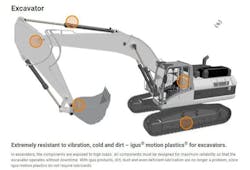How Generative AI is Improving Information Retrieval for Engineers
If you look at recent news articles about artificial intelligence (AI), you’ll read all about the potential for catastrophic job layoffs, deepfakes and unethical chatbots. For mechanical engineers, however, there’s a far more positive side to AI.
From design to manufacturing, emerging AI tools promise to make many engineering tasks better and faster than ever before. On the design side, these tools include the evolving generative design capabilities built into leading computer-aided design (CAD) systems. On the shop floor, AI plays a growing role in vision-guided robotics, as well as other process control and optimization systems.
READ MORE: Industry Outlook: A Frank Conversation on What’s in the Pipeline at igus
Yet, perhaps the most exciting development for engineers is the emergence of AI based on state-of-the-art deep learning algorithms and neural networks. At a high level, these new AI models can draw from text, speech, images, product specifications and other complex data types to synthesize useful engineering information. Thanks to increasingly affordable cloud computing power and application programming interface (API) access to generative AI models, advanced AI has become accessible to a growing number of engineering organizations.
One immediate use case of advanced AI in the engineering space involves intelligent product selection. Instead of simply returning products that match a specific user search query, AI-driven search relies on image recognition to infer the technical context of an application photo and then recommend suitable engineered products—even if the user did not have enough information to explicitly search for that product. An example of this intelligent approach to engineering product search can be found in the new igusGO platform.
A Generative AI Use Case for Information Retrieval
Designed specifically for igus, igusGO is a cloud platform and mobile app that uses image recognition models to retrieve relevant product and technical information about line of motions plastics, searching across hundreds of applications and thousands of products to help engineers find the right component for the job.
To use the app, users simply snap a picture of their equipment or application—whether it’s a packaging machine or excavator—along with the surroundings. The app then recommends suitable igus bearings, linear guides, cable carriers and other technologies. The product recommendations are intelligent in the sense that the AI can infer additional meaning from the photos, rather than relying solely on the user’s prior product knowledge.
For example, if a user snaps a picture of an excavator, the app doesn’t just list bearings with application keywords that explicitly match an “excavator” query. Rather, it will infer additional technical context, recommending bearings and additional components that can handle high loads; resist vibration; and withstand dust, dirt, cold temperatures and other outdoor conditions.
This ability to transcend the user’s product knowledge enables AI tools like igusGO to recommend engineered components in a technically rigorous way that matches real-world technical needs.
READ MORE: CAD/CAM Roundup: Engineering Software Productivity Tools and Services
The app also serves as a great example of the increasing accessibility of AI platforms. Rather than building an image recognition system from scratch—with all the machine learning challenges and deployment hurdles that a do-it-yourself approach implies—the company has leveraged the Amazon Web Services (AWS) Rekognition service, which provides API access to advanced and continuously improving image recognition models and infrastructure. It’s reasonable to expect other AI engineering tools will similarly make use of cloud-based AI models and infrastructure.
The Benefits of Fast, AI-Based Information Retrieval
One of the most immediate benefits of AI-based apps like igusGO is time savings. In this case, it only takes only a minute or two to snap a picture of a potential application, click through the app’s search results and even purchase parts in the online store (see sidebar, “Get It Fast With AI”). This process, end to end, eliminates the need to consult and search for appropriate motion plastics solutions, enabling engineers and machine builders to get the right parts for the job quickly and get to market faster.
Get it Fast With AI
Thanks to its product recognition capabilities, the igusGO app can also help machine designers and engineers quickly and easily reorder products. For example, once a user photographs an installed cable carrier, the app will identify the correct replacement part number from over 50 available product series. This product recognition capability enables companies to order spare parts quickly, keeping their downtime to a minimum.
Additional benefits include:
- Having the correct part reduces costs and maintenance for machines and systems.
- The app’s technically robust search suggestions enable users to see the potential for additional application improvements.
- The app improves sustainability efforts by suggesting self-lubricating solutions that may have been unknown to the user.
A Look Ahead to the Future
The igusGO app is one example of an AI technology that’s available for engineers to use now—but it’s really just the beginning. The use of AI for engineering tasks doesn’t stop with image recognition as a way to retrieve engineering information. An emerging frontier for AI is the ability to find or generate 3D models from image recognition or even natural language prompts.
For example, tell the AI you would like a flange bearing for a given shaft size with a custom flange dimension, and the AI would generate a suitable CAD model. To wit, igus is actively working with point cloud technology, which is a machine-readable way of representing objects in 3D space. Point clouds representing motion plastic components enable engineers to create exciting, new AI-to-CAD pipelines.
READ MORE: Low-Cost Automation Coming to Hannover Messe
Learn More
From image recognition services to large language models, new AI technologies are gaining lots of attention for their promise to change how individuals do their jobs. The good news is these state-of-the-art AI tools can help engineers be faster and more efficient than ever.
This article was submitted by Kai Finke, senior manager, Online Tools and Platforms at igus.





